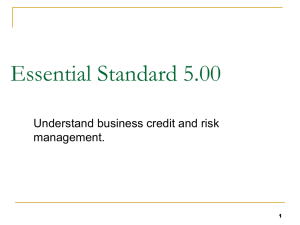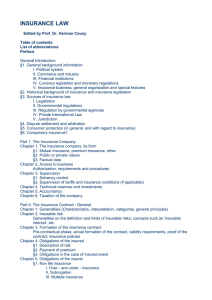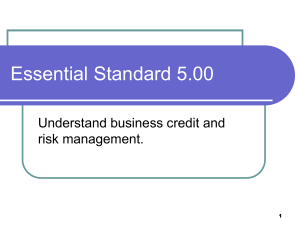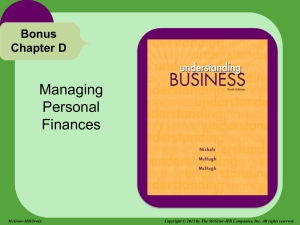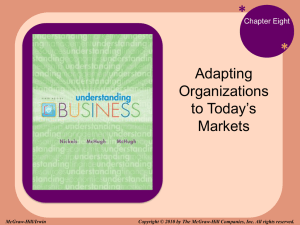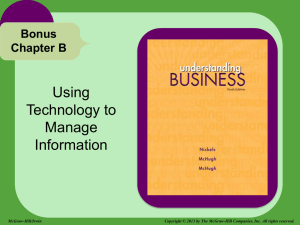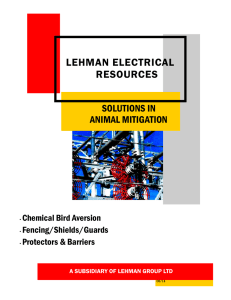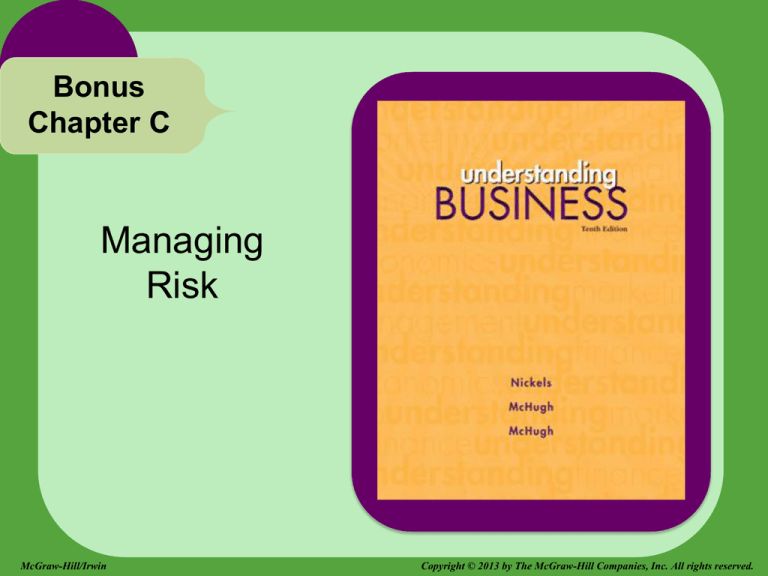
Bonus
Chapter C
Managing
Risk
McGraw-Hill/Irwin
Copyright © 2013 by The McGraw-Hill Companies, Inc. All rights reserved.
Bonus Chapter
C
LEARNING GOALS
1. Identify the environmental changes that have
made risk management important.
2. Explain the four ways of managing risk, and
distinguish between insurable and uninsurable
risk.
3. Define insurance policies, and explain the law
of large numbers and the rule of indemnity.
4. Discuss the various types of insurance
businesses can buy to manage risk.
C-2
Profile
JOACHIM OECHSLIN
Munich Re
• Oechslin is chief risk officer of
Munich Re; the world’s
largest reinsurer.
• Damage caused by a disaster
is not limited to the immediate
damage, but spreads
throughout the supply chain.
• Oechslin and his team predict
what those events will mean
and how much insurance
companies will have to pay.
C-3
Bonus Chapter
C
NAME that COMPANY
Every business faces risks that can affect the
health of the company. When the government
suspected some of our hens had been exposed
to bird flu, we killed and buried some 15,000
hens in northwestern Arkansas.
Name that company!
C-4
Understanding
Business Risks
LG1
WHAT’S ENTERPRISE RISK
MANAGEMENT?
• Goals of enterprise risk management (ERM):
1) Defining which risks the program will manage.
2) What risk management processes, technologies, and
investments will be required.
3) How risk management efforts will be coordinated across
the firm.
C-5
Managing Risk
WHAT’S RISK?
LG2
• Risk -- The chance of loss,
the degree of probability of
loss, and the amount of
possible loss.
• Speculative Risk -- A
chance of either profit or loss.
• Pure Risk -- The threat of
loss with no chance for profit.
C-6
Managing Risk
HOW to DEAL with PURE RISK
LG2
1) Reduce the risk
2) Avoid the risk
3) Self-insure against the
risk
4) Buy insurance against
the risk
C-7
Managing Risk
MOST COSTLY DISASTERS
LG2
Disaster
Year
Losses
Hurricane Katrina
2005
$122 Billion
Kobe, Japan Earthquake
1995
$100 Billion
Northridge California Earthquake
1994
$40 Billion
Hurricane Ike
2008
$35 Billion
Chilean Earthquake and Tsunami
2010
$30 Billion
Hurricane Andrew
1991
$28 Billion
9-11 Terrorist Attacks
2001
$21.37 Billion
Source: Fortune Magazine, April 11, 2011.
C-8
Self Insurance
WHAT’S SELF INSURANCE?
LG2
• Self-Insurance -- The practice of setting aside
money to cover routine claims and buying only
“catastrophe” insurance policies to cover big losses.
• Companies that selfinsure can “go bare”
and pay claims from
their operating budgets
or set up special funds
to pay for claims.
C-9
Buying
Insurance to
Cover Risk
LG2
WHAT RISKS are
UNINSURABLE?
• Uninsurable Risk -- A risk that no insurance
company will cover. Risks can include:
- Market risks
- Political risks
- Personal risks
- Operational risks
C-10
Buying
Insurance to
Cover Risk
WHAT RISKS are INSURABLE?
LG2
• Insurable Risk -- A risk that the typical insurance
company will cover, using the following guidelines:
1) The policyholder must have an insurable interest.
2) The loss must be measurable.
3) The chance of loss must be measureable.
4) The loss must be accidental.
5) The insurance company’s risk should be dispersed
among different areas.
6) The insurance company can set standards for accepting
risks.
C-11
Progress
Assessment
PROGRESS ASSESSMENT
• Why are companies more aware now of the need
to manage risk?
• What is the difference between pure risk and
speculative risk?
• What are the four major options for handling risk?
• What are some examples of uninsurable risk?
C-12
Understanding
Insurance
Policies
INSURANCE POLICIES
LG3
• Insurance Policy -- A written contract between the
insured and an insurance company that promises to
pay for all or part of the loss by the insured.
• Premium -- The fee the insurance company
charges, the cost of the policy to the insured.
• Claim -- A statement of loss that the insured sends
to the insurance company to request payment.
C-13
Understanding
Insurance
Policies
LG3
BASICS of
INSURANCE POLICIES
• Law of Large Numbers -- If a large number of
people or organizations are exposed to the same
risk, a predictable number of losses will occur during
a given period of time.
• Rule of Indemnity -An insured person or
organization can’t collect
more than the actual loss
from an insurable risk.
C-14
Types of
Insurance
Companies
LG3
TYPES of
INSURANCE COMPANIES
• Stock Insurance Company -- Owned by
stockholders, just like any other investor-owned
company.
• Mutual Insurance
Company -- An
organization owned by its
policyholders.
C-15
Types of
Insurance
Companies
LG3
STOCK and MUTUAL
INSURANCE COMPANIES
Stock Insurance
Companies
Mutual Insurance
Companies
Hartford Life
Mass Mutual
Metropolitan Life
New York Life
Prudential Life
Northwestern Mutual
C-16
Progress
Assessment
PROGRESS ASSESSMENT
• What is the law of large numbers?
• What is the rule of indemnity?
C-17
Health
Insurance
HEALTH INSURANCE CHANGES
LG4
• The U.S. is going through major changes in health
insurance.
• The debate of government involvement is ongoing.
• We are likely to see many variations of health
coverage in the future.
C-18
Health
Insurance
LG4
EMPLOYER HEALTH
INSURANCE OPTIONS
• Health Maintenance Organizations (HMOs) -Offer a full range of healthcare benefits, with
emphasis on helping members stay healthy through
preventative care; restricted list of doctors.
• Preferred Provider Organizations (PPOs) -Contract with hospitals and physicians, members
usually pay some part of the bill; choose physician.
• Health Savings Accounts (HSAs) -- Tax-deferred
savings accounts linked to low cost, high-deductible
health insurance policies.
C-19
Disability
Insurance and
Workers’
Compensation
OTHER TYPES of INSURANCE
LG4
• Disability insurance
replaces part of your
income if you become
disabled and can’t work.
• Worker’s compensation
insurance guarantees
payment of wages, medical
care and rehabilitation for
employees injured on the
job.
C-20
Disability
Insurance and
Workers’
Compensation
LG4
GETTING the MOST out of
LIFE INSURANCE
1. Quit smoking, lose weight
and go to the gym!
2. Figure out how much
insurance you need.
3. Pick a good insurance
company.
4. Find a good financial
planner.
Source: Entrepreneur, March 2010.
C-21
Liability
Insurance
LIABILITY INSURANCE
LG4
• Professional liability
insurance covers people
found liable for professional
negligence; also known as
malpractice insurance.
• Product liability insurance
covers liability arising out of
products sold.
Photo Courtesy of: Paul Wilson
C-22
Insurance
Coverage for
Home-Based
Businesses
HOME-BASED BUSINESSES
LG4
• Homeowners’ policies
usually don’t provide
protection for homebased businesses.
• For more coverage, you
may need to add a rider
to your homeowner’s
policy.
C-23
Insurance
Coverage for
Home-Based
Businesses
LG4
HOME MATTERS
What You Need to Know About Home Insurance
1. Not all policies cover
home-based businesses.
2. Don’t buy too much
coverage.
3. Small claims can add up.
4. The home’s history
matters.
Source: Money, September 2010.
C-24
Progress
Assessment
PROGRESS ASSESSMENT
• Why should someone buy disability insurance?
• How many different kinds of private insurance
can you name?
C-25

